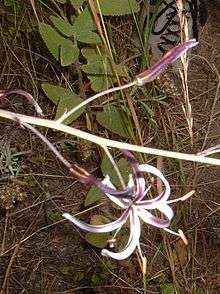Chlorogalum
| Chlorogalum Soap plant, Amole | |
|---|---|
 | |
| Chlorogalum pomeridianum Wavy-leafed Soap Plant | |
| Scientific classification | |
| Kingdom: | Plantae |
| Clade: | Angiosperms |
| Clade: | Monocots |
| Order: | Asparagales |
| Family: | Asparagaceae |
| Subfamily: | Agavoideae |
| Genus: | Chlorogalum (Lindl.) Kunth |
| Synonyms[1][2] | |
| |
The common names soap plant, soaproot and amole refer to the genus Chlorogalum. They are native to western North America, from Oregon to Baja California, and are mostly found in California. Common names of the genus and several species derive from their use as soap.
Soap plants are perennial plants, with more or less elongated bulbs, depending on the species. The bulbs can be white or brown, and in most species have a fibrous coat. The flowers are borne on a long central stem, and appear to have six separate petals (not all are petals in the technical sense). There are six stamens, which are prominent in most species.
Taxonomy
The placement of the genus Chlorogalum has varied considerably. In the APG III system, followed here, it is placed in the family Asparagaceae, subfamily Agavoideae, based on molecular systematics evidence.[4] The second edition of the Jepson Manual places the genus in Agavaceae (equivalent to the APG III subfamily Agavoideae).[5] Until the 1980s, the genus was generally treated in the Lily family, Liliaceae, in the order Liliales, e.g. the Flora of North America, published in 1993 onwards, has Chlorogalum in Liliaceae.[6] The genus has also been placed in its own family, Chorogalaceae, or in a group within the hyacinth family Hyacinthaceae (now Scilloideae), in the order Asparagales. Phylogenetic studies based on molecular evidence (e.g. Pfosser and Speta 1999), suggested that, along with Camassia, Chlorogalum seemed to be most closely related to Agave and Anthericum.
Species
Five species are currently classified in the genus.[1] All except the Wavy-leafed Soap Plant, Chlorogalum pomeridianum, have rather restricted distributions, with little overlap. The Wavy-leafed Soap Plant, however, has a range that virtually encompasses those of all other members of the genus, and is the most common of them.
- Chlorogalum angustifolium, Narrow-leaf Soap Plant, found in the inner north Pacific Coast Ranges of California and southern Oregon and the Sierra Nevada foothills
- Chlorogalum grandiflorum, Red Hills Soaproot, found in the north and central Sierra Nevada foothills
- Chlorogalum parviflorum, Small-flowered Soaproot, found in the south coastal region of California, south of Santa Barbara, and into Baja California
- Chlorogalum pomeridianum, Wavy-leafed Soap Plant, found anywhere in California except the higher Sierra Nevada and the deserts, and also in south-western Oregon
- Chlorogalum purpureum, Purple Amole, found in the Outer South Coast Ranges of California, south of Monterey Bay and north of Santa Barbara
Uses
The fibers surrounding the bulb were widely used, bound together, to make small brushes. Extracts of the bulbs could also be used as a sealant or glue.
- Cleansing
At least two of the species are used for detergent properties by Native Americans and early European settlers, specifically the C. pomeridianum by tribes including Miwok,[7] and the C. angustifolium by the Karuk people .[8] The juices of the bulb contain saponins that form a lather when mixed with water,[9] making the bulbs useful as a kind of soap. This is the origin of several of the plants' common names. It was particularly used for washing hair, since C. pomeridianum at least was held to be effective against dandruff.[10]
- Cuisine
The young leaves of certain species can be used as food, but the saponins in the bulbs make these poisonous. However saponins are very poorly absorbed by the body and usually pass straight through, and in any case they can be destroyed by thorough cooking. The Miwok people roasted and ate the bulbs as a winter food.[10] In February 1847 Patrick Breen of the ill-fated Donner Party recorded that a Native American gave the starving settler some "roots resembling Onions in shape [that] taste some like a sweet potatoe [sic], all full of little tough fibres." Breen's son later called the roots "California soap-root"—almost certainly C. pomeridianum.
Saponins are much more toxic to some other animals than they are to humans. Fish are particularly susceptible, and the bulb juices were used to kill or stun them so they could be caught easily.
- Medicinal
The bulbs also had various medicinal uses, both external (e.g., for making a poultice to be used as an antiseptic, or as a rub in cases of rheumatism) and internal (decoctions were used for a range of purposes, including as a diuretic, as a laxative and against stomachache).[10]
References
- 1 2 Search for "Chlorogalum", World Checklist of Selected Plant Families, Royal Botanic Gardens, Kew, retrieved 2012-05-05
- ↑ Kunth, Karl Sigismund 1843. Enumeratio Plantarum Omnium Hucusque Cognitarum 4: 681-683 in Latin
- ↑ Lindley, John 1841. Edwards's Botanical Register n. ser. 4: 54
- ↑ Stevens, P.F., Angiosperm Phylogeny Website: Asparagales: Agavoideae
- ↑ Bruce G. Baldwin; Douglas H. Goldman; David J Keil; Robert Patterson; Thomas J. Rosatti, eds. (2012). The Jepson Manual Vascular Plants of California (2nd ed.). University of California Press. ISBN 9780520253124.
- ↑ Flora of North America. New York and Oxford: Flora of North America Editorial Committee, eds. 1993.
- ↑ C.M. Hogan, 2008
- ↑ University of Michigan at Dearborn: Native American Ethnobotany of Chlorogalum angustifolium
- ↑ Soap Lilies in California, 1998
- 1 2 3 Univ. of Michigan: Species entry in Moerman's Native American Ethnobotany Database: Chlorogalum pomeridianum
- Pfosser, M. and Speta, F. (1999) Phylogenetics of Hyacinthaceae based on plastid DNA sequences. Annals of the Missouri Botanical Garden, 86, 852-875.
External links
| Wikispecies has information related to: Chlorogalum |
- CalFlora Database: genus Chlorogalum
- Chlorogalum genus treatment from the Jepson Manual
- Palomar College website: Soap Lilies in California
| Wikimedia Commons has media related to Chlorogalum. |